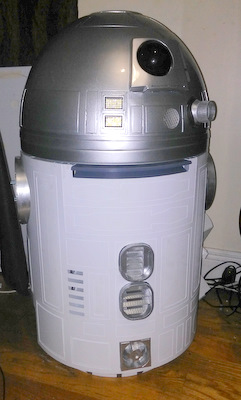This was originally a luggage strap. I use it in place of a bungee cord to hold the skins in place while fitting the band clamps.
Unless you have a helper you will need something like it.
I've allways called these band clamps. However, they are known better as "ratcheting tie downs". If you not familiar with them check out this additional information (it includes places you can buy cheap clamps!)
In the instructions that follow they will be called band clamps.
We are going to be working without the Ring0, the bottom ring, attached to the frame. It will make the skin install easier. The frame needs to be raised up so the bottom edges of the skins clear the working surface. You'll need about .25 inch of clearance.
Even though the frame is made of .1875 (3/16) styrene you'll find the rings are easy to deflect slightly up and down. To hold the top of the frame flat it's a good idea to clamp your Rockler bearing in place.
Pauls instructions called for pieces of angle iron to keep from distorting the frame. I used pieces of square metal tubing in whatever sizes they happened to be when I grabbed them. BAD IDEA.
When I went to turn the frame over in order to work on the bottom I found I needed a very big spacer in order to reach past the oversize pieces.
I've since cut those pieces all to 24 inches!
If your band clamps have big iron hooks you'll want to put something between them and the frame to prevent scratching your skins
You'll also want to be sure the hooks don't get caught on the edge of a rib as you are tightening the clamps
